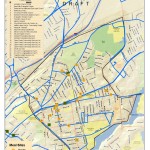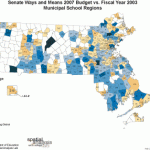The Food Bank of Western Massachusetts sought mapping and analysis support from the Spatial Analysis Lab during the summer of 2010. The project is currently on hold, but you can view some of the initial map products below. Sarah Motti ’10 provided assistance on the project during her summer employment in the SAL. In many […]
Category Archives: Community
Bike Trail Mapping
The Spatial Analysis Lab (SAL) recently finished the 2011 version of the “Easthampton ~ Northampton Trail & Bicycle Map” for the Friends of Northampton (MA) Trails and Greenways (FNTG) organization. The 2011 series marks the third iteration of the map series which started back in 2006. The Bike Map series represents countless hours of effort […]
Healthy Communities
The Spatial Analysis Lab provided mapping and spatial analysis to Cooley Dickinson Hospital (Northampton, MA) as part of their 2011 Community Health Assessment report.
What does your policy look like?
Back in February 2007 I asked one of my student assistants to generate a new map for the mystery map series. At that time I was very interested in visualizing administrative policies manifestation on the landscape. All too often, policies are created and enacted without any insight as to how they will overlay on the […]
Watering the rain
photo taken June 09 2009 Seeing the sprinklers water the lawn after 0.3″ of rain the other day got me thinking there has to be a better way. I’ll admit that I don’t know how or when the sprinklers are set to water, but this is 2009 and we are Smith College!! Why not have […]
Springtime on Campus
What a great time of year. A time to relax, reflect, and smell the springtime flowers. Oh, and yes, there a plenty of opportunities to take in that pesticide residue smell… 🙁 Note: photos are geotagged. Download this Google Earth file (pesticides2009.kmz) so you can plan ahead, or around, if you like 😉 ——————————————————————————————————–
Geography Lesson for Legislators
Illustrating those same data on a map, which ironically, had not been done before, demonstrated the inequities of the proposals and actually helped generate better funding for the disadvantaged districts.

